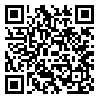Effect of insulin resistance on substrate selection during exercise in inactive obese diabetic women
Department of exercise physiology, Faculty of physical education and sport science, Shahid Bahonar University of kerman , r_nikooie@uk.ac.ir
Abstract: (4687 Views)
Background: This semi-experimental study aimed to investigate the effect of insulin resistance on substrate selection during exercise in obese diabetic women.
Methods: 24 inactive obese women, including control (C; n=8,BMI=31.03±1.18), non-insulin resistance (NIR;n=8,BMI=30.91±0.78), and insulin resistance (IR, n=8,BMI=31.57±0.91) groups, were purposely selected and performed a standard incremental test with an initial workload of 50 W and increased in the workload of 20 W every three minutes. Respiratory gases were collected throughout the test. Cross-over point (COP), a point at which the metabolic substrate changes from fat to carbohydrates, and FATmax point at which fat has the highest contribution to energy supply, were determined. Heart rate and oxygen consumption corresponding to COP and FATmax, points were calculated and compared among the groups using one-way analysis of variance (ANOVA).
Results: In both diabetic groups, heart rate (P<0.001) and oxygen consumption (P<0.001) corresponding to COP were significantly lower compared to the C. Both variables had lower values in the IR compared to the NIR (P<0.001). In both diabetic groups, oxygen consumption corresponding to the FATmax point was significantly lower compared to the C (P<0.001) and had lower values in IR compared to the NIR (P<0.001). Conclusion: In general, the results of the present study showed that insulin resistance is associated with more reliance on carbohydrates and diminished fat oxidation at submaximal exercise intensities.
Methods: 24 inactive obese women, including control (C; n=8,BMI=31.03±1.18), non-insulin resistance (NIR;n=8,BMI=30.91±0.78), and insulin resistance (IR, n=8,BMI=31.57±0.91) groups, were purposely selected and performed a standard incremental test with an initial workload of 50 W and increased in the workload of 20 W every three minutes. Respiratory gases were collected throughout the test. Cross-over point (COP), a point at which the metabolic substrate changes from fat to carbohydrates, and FATmax point at which fat has the highest contribution to energy supply, were determined. Heart rate and oxygen consumption corresponding to COP and FATmax, points were calculated and compared among the groups using one-way analysis of variance (ANOVA).
Results: In both diabetic groups, heart rate (P<0.001) and oxygen consumption (P<0.001) corresponding to COP were significantly lower compared to the C. Both variables had lower values in the IR compared to the NIR (P<0.001). In both diabetic groups, oxygen consumption corresponding to the FATmax point was significantly lower compared to the C (P<0.001) and had lower values in IR compared to the NIR (P<0.001). Conclusion: In general, the results of the present study showed that insulin resistance is associated with more reliance on carbohydrates and diminished fat oxidation at submaximal exercise intensities.
Send email to the article author
| Rights and permissions | |
 |
This work is licensed under a Creative Commons Attribution-NonCommercial 4.0 International License. |


